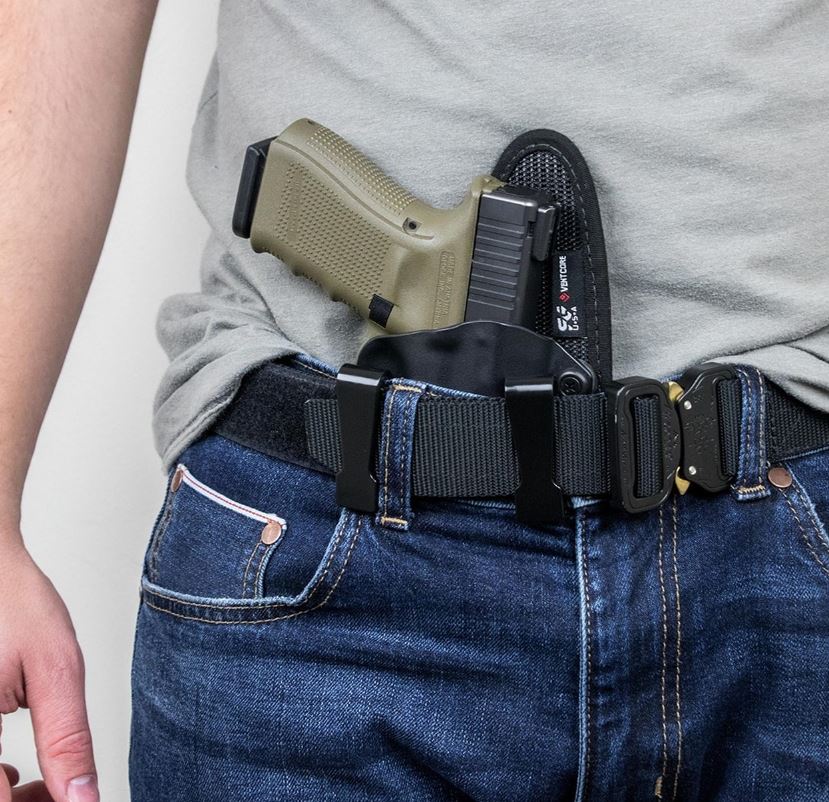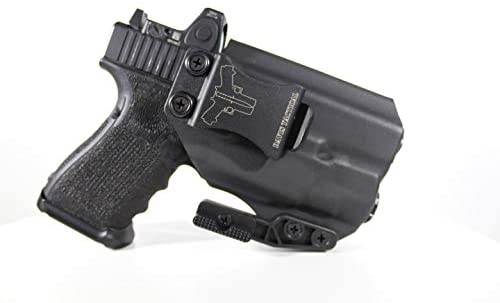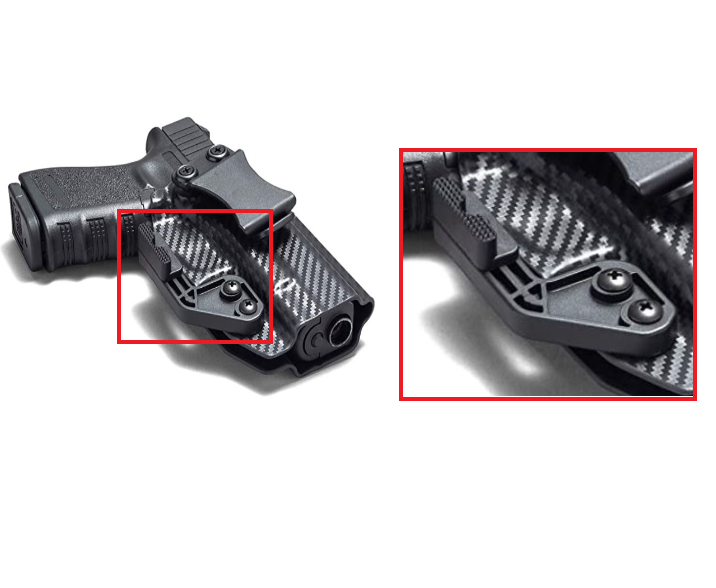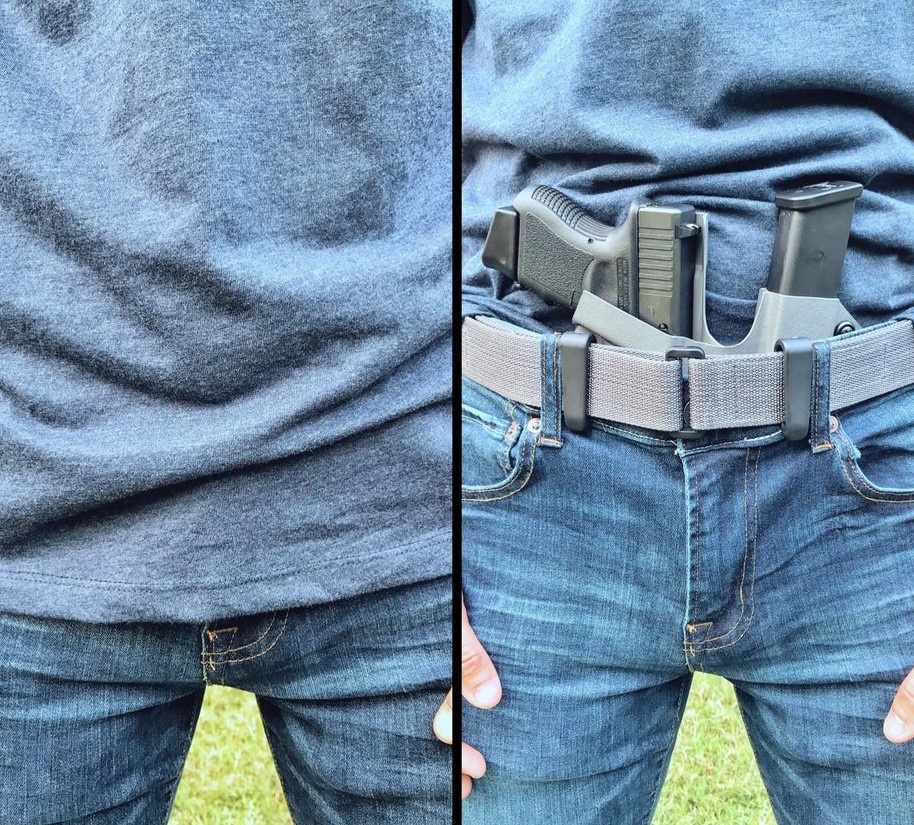Image Provided By American Survival Guide
Appendix carry has become one of the most popular methods for concealing your gun in a holster.
But, many people find it difficult to appendix carry comfortably?
Lets take a look at some of the best ways to appendix carry comfortably.
How to Comfortably Appendix Carry a Holster
What is Appendix Carry?
Appendix carrying your gun, in a holster, is where you place a pistol and holster in the front of the waistband.
Usually, appendix carry holsters are carried inside of your waistband (IWB) and less commonly outside of the waistband (OWB).
Typical placement is often about halfway between the pants pocket and the belly button, close to the location of the appendix, hence the name appendix carry.
Also, appendix carry holsters are available for both left or right hand draw.
Check out other concealed carry methods by clicking here.

What Are The Advantages of Appendix Carrying Holsters?
The biggest advantage of an appendix carry is ease of drawing your weapon.
Appendix carry holsters are in a position that is natural to most people.
Typically, for most of us our hands are usually going to be in front of our body, so this becomes a familiar position for us navigate, especially when we don't have time to look at what we're grabbing.
This holster position also allows us to easily use our non-dominant hand to assist us in drawing our weapon.
For example, if your concealing your weapon with a shirt, the non-dominant hand will typically be used to pull the shirt up to uncover your gun, while the dominant hand will be used to draw your weapon.
Also, generally most of us are taught by trainers to keep our hands in the front of our hips in a neutral position prior to drawing your weapon.
Furthermore, you can draw your weapon with either one of your hands.
Although drawing your weapon with your non-dominant hand may be a bit awkward, it's still fairly easy to do with good training.
Carrying your body armor with appendix carry holster is another advantage of this appendix carry holster.
Body armor is typically strongest in the front and weaker on the sides. Hence, we would typically want to face toward our enemy for best protection.
Drawing your weapon from an appendix holster will typically keep your chest facing toward the enemy, therefore keeping the strongest part of your bullet proof vest protecting you from that enemy.
Good for concealing a weapon. In addition, a handgun carried on the front side of our body in a holster is less likely to show on our covering garment as we bend.
It works especially well when the covering garment is a t-shirt, sweatshirt or buttoned shirt that is worn with the shirt-tail out.
It's an overall good conceal carry method that won't expose your weapon. But, compact weapons are more ideal for this carry method.
Check out this video below showing a good proper technique for appendix drawing from a holster provide by Rein Henrichs.
Appendix Carry Holsters and Body Size
Skinner Individuals
Yes, size matters. For skinnier individuals, you should generally avoid canting your holsters.
Skinnier individuals will typically have more bones exposed and less cushion, therefore avoiding holster cant will reduce the butt of the gun digging into your hip and causing discomfort.
Ride height for skinner individuals will typically be higher since there more room for your weapon up toward your abdomen then there is down in your lower abdomen to reduce the muzzle end of the holster from digging into your skin.
But, if your really set on carrying your holster with a cant, just try moving your holster more toward your bodies centerline to reduce digging.
Bigger individuals
For bigger individuals, canting your holster is recommended. Bigger individuals generally don’t need to worry about their gun digging into their hip bone in the appendix position, because they’ve got more cushion.
Therefore, canting your holster will reduce digging into your upper abdomen, especially if it's larger.
In addition to canting, lowering the ride height of your holsters is also will reduce the discomfort of the holster digging into your upper abdomen.
See the video below for a great holster option for bigger size individuals provided by Black Diamond Guns and Gear.
Gun and Holster Size
Generally, smaller more compact guns such a Glock 26 or Glock 43 will be more ideal for appendix carry.
They're a lot smaller and will typically have less discomfort from digging into your skin.
Furthermore, smaller guns will give you more flexibility to bend or sit then bigger guns such as a Glock 21.
Gun, Holster, and Accessories
Yes, it's possible to carry accessories on your gun such as an optic and or laser and or combo when you appendix carry your gun.
Check out the example below, a Davis Tactical IWB Holster that is optic and or sight and or laser combo compatible.
It's also possible to carry a holster with a mag carrier attachment, but we recommend you carry this separated from your holster for comfort. This option is only ideal for skinner individuals.
Image below is a holster made for Glock 19.

In the above example, you can already see that the holster and gun, along with the optic and or laser and or light combo will be bulky.
There is a few things you can do to help increase your comfort and decrease printing, when appendix carrying a bulky holster.
Claw and Wedge Attachments
The Claw and or Wedge are commonly used in appendix carry holsters. They were designed to push the holster into your body to reduce printing from the butt of your gun.
These would be a good option for a bigger size handguns. However, these may not be a good option for bigger sized individuals.
Pictured below is example of a claw on an IWB holsters.
Holster Claw

Holster Wedge

Adjustability
Having the ability to adjust your holster will be important for a bulky holster.
Adjusting cant and ride height will help with the gun and holster digging into your body, specifically, your upper and lower abdomen, hip bones, and legs. It will help you find the sweet spot.
This is especially important when you have a bulky holster and larger handgun.
Belt
It's important to have a good adjustable belt when your appendix carry your holster. If this is your preferred method of carry, you're likely going to carry your weapon for most of the day.
Therefore, it's important to have a strong (to carry the the full weight of your gun and holster) and be easily adjustable.
For instance, we might have to bend over, run to our car in rain, stand up, and or sit down many times throughout the day.
Having an easily adjustable belt that we can loose when we need some slack or tighten when we need load bearing support is important for comfort and security.
Check out the video below provide by Warrior Poet Society that's a good comparison of different types of belts, that includes for EDC purpose. This includes adjustability and how this might be a good option for and everyday carry holster.
Final Thoughts
Appendix carry is great option for conceal carry, but it does have downsides. Most important factor to consider when carrying any holster is comfort, so choose wisely.
With Appendix carry, it's important to find a holster that allows you to adjust cant and ride height so that you can to find your sweet spot regardless of your body size.

